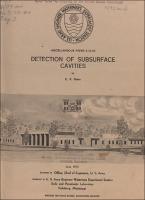Please use this identifier to cite or link to this item:
https://hdl.handle.net/11681/20715Full metadata record
| DC Field | Value | Language |
|---|---|---|
| dc.contributor.author | Bates, Edward R. | - |
| dc.date.accessioned | 2017-01-17T21:34:00Z | - |
| dc.date.available | 2017-01-17T21:34:00Z | - |
| dc.date.issued | 1973-06 | - |
| dc.identifier.uri | http://hdl.handle.net/11681/20715 | - |
| dc.description | Miscellaneous Paper | - |
| dc.description | Abstract: Many scattered attempts have been made to apply geophysical and remote-sensing methods to the problem of detecting underground cavities, but only a few attempts have shown any real promise and even these have given no consistent results. However, by combining the knowledge gained from all these efforts, it became apparent that some of the geophysical methods clearly showed promise if they could be modified and improved to apply specifically to the problem of cavity detection. None of the remote-sensing (airborne) methods showed any promise for detecting specific cavities because their practical and theoretical capabilities of depth penetration and resolution precluded this application, However, they may be useful in selecting areas for more detailed study by other methods. The geophysical methods that showed the most promise were variations of seismic subsurface profiling and various electrical geophysical prospecting methods. Since seismic methods had been successful only in detecting cavities whose radii equalled the depth of overburden, the electrical methods were selected as most deserving of further investigation. Self-potential, equipotential, and electrical resistivity surveys have all shown some success in either foreign or domestic research efforts. Research has been in progress since July 1970 at the U.S. Army Engineer Waterways Experiment Station to determine which of the above methods offers the most promising results for detecting subsurface cavities and what might be done to further develop them. Through extensive field tests, it has been determined that none of the standard electrical resistivity procedures give consistently good results. However, as a result of the initial rield testing, a new process of data interpretation has been developed for one specific electrode configuration. The modified procedure produced excellent results during field tests over known cavities in Indiana and Missouri. Cavities less than 10 ft in diameter and at depths greater than 100 ft were located. To date, this new procedure has teen applied only to air-filled cavities. However, research is continuing to adapt this process for locating water- or mud-filled cavities. NOTE: This file is large. Allow your browser several minutes to download the file. | - |
| dc.publisher | Soils and Pavements Laboratory (U.S.) | - |
| dc.publisher | Engineer Research and Development Center (U.S.) | - |
| dc.relation | http://acwc.sdp.sirsi.net/client/en_US/search/asset/1047290 | - |
| dc.rights | Approved for public release; distribution is unlimited. | - |
| dc.source | This Digital Resource was created from scans of the Print Resource | - |
| dc.subject | Detection | - |
| dc.subject | Electrical resistivity | - |
| dc.subject | Geophysical exploration | - |
| dc.subject | Remote sensing | - |
| dc.subject | Subsurface investigations | - |
| dc.subject | Underground cavities | - |
| dc.subject | Geophysical surveys | - |
| dc.subject | Geology | - |
| dc.title | Detection of subsurface cavities | - |
| dc.type | Report | en_US |
| Appears in Collections: | Miscellaneous Paper | |
Files in This Item:
| File | Description | Size | Format | |
|---|---|---|---|---|
| MP-S-73-40.pdf | 29.36 MB | Adobe PDF |  View/Open |